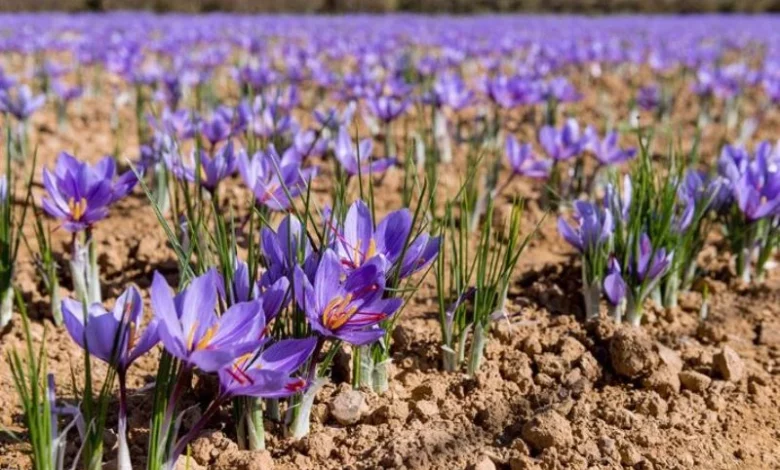Saffron Spice Cultivation in India – Essential Guidelines
Saffron Spice Cultivation in India And all required information

Kesar or Zafran- is a costly spice worldwide and is an interesting plant since it can grow almost anywhere. Red gold is the nickname of saffron spice because this is an expensive spice. Farmers cultivate saffron mainly in Himachal Pradesh and Jammu, and Kashmir. However, it can grow almost anywhere in the world. This spice is costly because it is extremely difficult to harvest the crop.
The saffron crop grows up to 20 cm in height and is a bulbous perennial plant with rounded corms. It is the corm that farmers plant for the cultivation of saffron. Saffron or saffron flowers vary in colour from lilac to purple. The style is yellowish, while the stigmata are bright red. Farmers divide saffron flowers into three branches. The red coloured stigmas of the flowers are harvested and used for spice.
Farming requires the most variety of equipment, which plays a major role in the processing of agriculture. Tools, harvesters and tractors are the main in the cultivation of saffron; Hence, we suggest the New Holland 3600 tractor, which is better for increasing efficiency in the field.
Table of Contents
Uses of Saffron
The most prominent use of saffron is as a colouring and flavouring agent in milk and milk sweets. Moreover, we can use it as a seasoning in meat, cheese, mayonnaise etc. Thus, we can say that saffron is popular as a seasoning and flavouring in Mughlai cuisine. We can also use it for liver enlargement, infertility, healing arthritis, and fever in Ayurveda.
Ideal Conditions for Saffron Cultivation
Farmers can grow saffron almost anywhere. The primary requirement is fertile soil for commercial saffron production. According to the study, the next big factor is the climate in saffron cultivation. It needs dry soil and good photoperiod with light moisture.
pH Required for Saffron Cultivation
Saffron prefers acidic soil. Farmers grow it best when the soil pH is 5.5 to 8.5.
Climate for Saffron Cultivation
The ideal climate for growing saffron is a warm, subtropical climate. Saffron grows best at an altitude of 2000 m above sea level. This spice requires a photoperiod of 12 hours. Apart from this, it needs 12 hours of sunlight for good growth.
The season for Saffron Farming
In India, farmers cultivate saffron corms during June and July. At some places, farmers cultivate it in August and September. The Saffron plant starts flowering in October. Saffron requires extreme heat and extreme cold in winter as well as dryness in summer. Consequently, maximum vegetative growth occurs in winter. Such weather prevails over parts of Karnataka, Himachal Pradesh and Jammu and Kashmir.
Soil for Saffron Farming
In saffron cultivation, the soil is one of the primary requirements. It can grow in loamy, loamy or calcareous soils. Gravel soil is also favourable for the cultivation of saffron. The soil does not need to have a good moisture retention capacity. Because saffron requires moderate amounts of moisture during the growth and extreme dryness in summer. However, heavy soils are not suitable for saffron cultivation.
Water Requirement in Saffron Cultivation
The saffron crop requires less water. Therefore, farmers should use soil that is not completely dry but just moist. Unlike many other crops, it does not require very wet soil. However, they should use the soil slightly moist for optimum growth. In case of erratic rains, sprinkler irrigation is the most commonly followed practice.
About 283 m3 per acre of water farmers should distribute during the entire period of saffron cultivation. They can Irrigate the crop every week. It promotes vegetative growth and facilitates flowering. Before flowering, farmers should irrigate in the last week of August and till the middle of October. The last three irrigations are done in November to promote the vegetative growth of saffron.
Crop Rotation with Saffron
Research has shown that repeated cultivation of saffron in the same field makes the soil ‘sick’. In other words, fertility is affected. Sowing beans are effective in increasing saffron crop yield and increasing corm size. After one round of saffron cultivation, it is recommended not to cultivate saffron for 8-10 years.
Land Preparation for Saffron Cultivation in India
For the cultivation of saffron, farmers should plough the land two to three times. It should be free from previous crop stones, debris, rocks and earth clods. Frequent tillage helps in loosening the soil, brings the subsoil to the surface and also increases fertility.
Farm manure and organic matter are also added to the soil before cultivation. Farmers can cultivate saffron both in beds and also in pits. Pits are dug 12-15 cm deep with an inter-plant spacing of 10 cm.
For land preparation, a tractor is the most prominent equipment in farming. Thus we suggest the New holland 3630 tractors. This tractor is the best and is made according to every Indian farmer.
There are guidelines about saffron farming; for more information regarding other farming, stay tuned with us.




